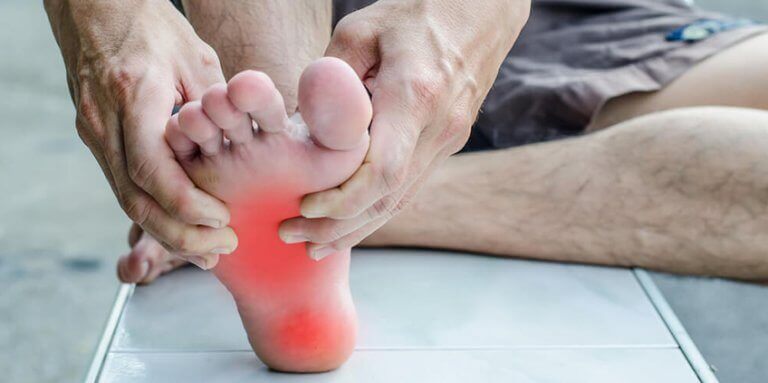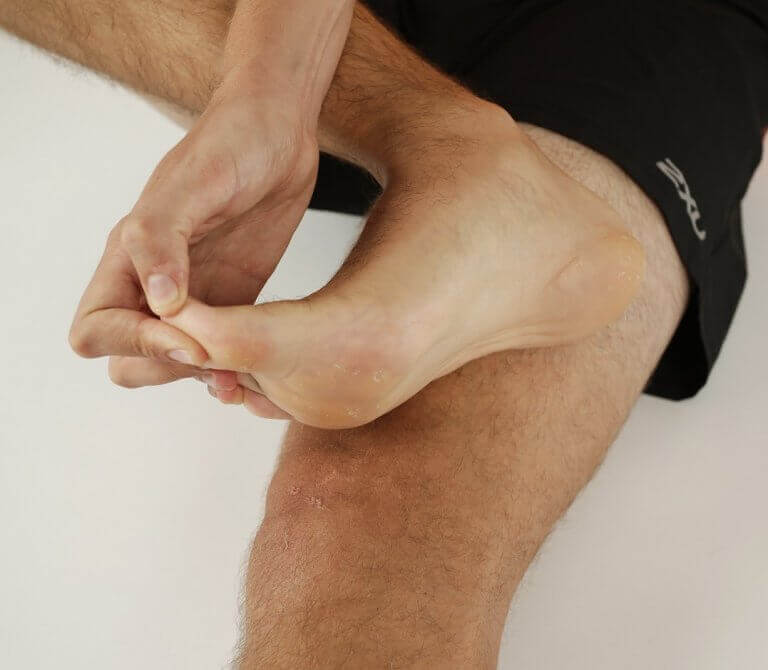Easy Ways to Prevent Plantar Fasciitis

Plantar fasciitis is a pathology with effects that severely limit the lives of people who suffer from it. Not being able to walk without feeling a sharp pain in the soles of your feet can be agony. Let’s take a look at what we can do to prevent plantar fasciitis.
What is plantar fasciitis?
Let’s begin by defining what plantar fasciitis really is. As with other pathologies whose name ends in ‘itis’, we’re facing a problem that causes inflammation. In this specific case, it causes inflammation in the plantar fascia.
The plantar fascia is an elastic tissue that runs from the bone of the ankle (the calcaneus) to the metatarsal area of the toes. This means that it practically covers the entirety of the foot’s sole. Its function is to maintain the arch of the foot while walking, as well as absorbing and distributing the forces that impact our feet when we’re standing up.
Causes and prevention
To understand how to prevent an injury, we must know the causes that produce it. In the case of plantar fasciitis, the causes are usually related to putting the plantar fascia under excessive effort:
- Excessive use. Distance runners are the ones who suffer from this problem more frequently. Demanding the maximum effort from the fascia during long periods of time can cause these ailments to appear.
- Running on irregular surfaces. Another way to overload the fascia is by making it work more intensely. In this case, an irregular surface will force the fascia to remain stable while facing tugs and pressure from multiple angles.
- Foot curves. Suffering from pes cavus (an excess of curvature in the feet) will also predispose us to get plantar fasciitis.
- Obesity. The more we weigh, the more force we apply on the plantar fascia. This is another factor that can promote the appearance of plantar fasciitis symptoms.

The prevention of plantar fasciitis
With all of the previous information, it’s easier to understand the following recommendations to prevent plantar fasciitis.
In the first place, we must try to switch between running sessions and other types of exercises. Riding a bike, swimming, doing circuits and other exercise modalities in the gym or at home are great options.
It’s also preferable to run on smooth and soft surfaces. Running on asphalt all the time may not be such a good idea. The hardness of asphalt may have a negative impact on our fascia and knees.
Finally, also related to running, we must make sure that we’re wearing appropriate shoes. This leads to our next point: knowing our physiology.
It’s convenient to perform a study about the way we step. Knowing if we tend to lean on one side more than the other, or if our feet are too curved or too flat, will help us decide what kind of shoes to buy, and whether we need to wear corrective shoe inserts or not. If we don’t do this, we may be damaging our body every time we run or walk, without even knowing.
It’s also important to not spend too much time standing up each day. Unless we absolutely have to stand because of work, it isn’t good for the body to spend many hours standing and constantly applying pressure on the fascia.

This is even more important if we’re overweight. If you want to prevent these types of pathologies and many others as well, it may be a good idea to consider losing weight.
Other options to prevent plantar fasciitis
Likewise, it’s beneficial to do some leg and fascia stretches. In this regard, stretching the calves and soleus will help to keep the muscles healthy, and the Achilles tendon prepared to resist the efforts we may demand.
As a last option, there’s physical therapy. Besides recommending exercises and stretches, a physical therapist will have various methods to relax the muscles and fascia, including techniques such as thermotherapy, cryotherapy, and electrotherapy.
On top of that, massaging the soles of our feet properly can also help to prevent injuries. This is something that we can do at home.
Plantar fasciitis is a pathology with effects that severely limit the lives of people who suffer from it. Not being able to walk without feeling a sharp pain in the soles of your feet can be agony. Let’s take a look at what we can do to prevent plantar fasciitis.
What is plantar fasciitis?
Let’s begin by defining what plantar fasciitis really is. As with other pathologies whose name ends in ‘itis’, we’re facing a problem that causes inflammation. In this specific case, it causes inflammation in the plantar fascia.
The plantar fascia is an elastic tissue that runs from the bone of the ankle (the calcaneus) to the metatarsal area of the toes. This means that it practically covers the entirety of the foot’s sole. Its function is to maintain the arch of the foot while walking, as well as absorbing and distributing the forces that impact our feet when we’re standing up.
Causes and prevention
To understand how to prevent an injury, we must know the causes that produce it. In the case of plantar fasciitis, the causes are usually related to putting the plantar fascia under excessive effort:
- Excessive use. Distance runners are the ones who suffer from this problem more frequently. Demanding the maximum effort from the fascia during long periods of time can cause these ailments to appear.
- Running on irregular surfaces. Another way to overload the fascia is by making it work more intensely. In this case, an irregular surface will force the fascia to remain stable while facing tugs and pressure from multiple angles.
- Foot curves. Suffering from pes cavus (an excess of curvature in the feet) will also predispose us to get plantar fasciitis.
- Obesity. The more we weigh, the more force we apply on the plantar fascia. This is another factor that can promote the appearance of plantar fasciitis symptoms.

The prevention of plantar fasciitis
With all of the previous information, it’s easier to understand the following recommendations to prevent plantar fasciitis.
In the first place, we must try to switch between running sessions and other types of exercises. Riding a bike, swimming, doing circuits and other exercise modalities in the gym or at home are great options.
It’s also preferable to run on smooth and soft surfaces. Running on asphalt all the time may not be such a good idea. The hardness of asphalt may have a negative impact on our fascia and knees.
Finally, also related to running, we must make sure that we’re wearing appropriate shoes. This leads to our next point: knowing our physiology.
It’s convenient to perform a study about the way we step. Knowing if we tend to lean on one side more than the other, or if our feet are too curved or too flat, will help us decide what kind of shoes to buy, and whether we need to wear corrective shoe inserts or not. If we don’t do this, we may be damaging our body every time we run or walk, without even knowing.
It’s also important to not spend too much time standing up each day. Unless we absolutely have to stand because of work, it isn’t good for the body to spend many hours standing and constantly applying pressure on the fascia.

This is even more important if we’re overweight. If you want to prevent these types of pathologies and many others as well, it may be a good idea to consider losing weight.
Other options to prevent plantar fasciitis
Likewise, it’s beneficial to do some leg and fascia stretches. In this regard, stretching the calves and soleus will help to keep the muscles healthy, and the Achilles tendon prepared to resist the efforts we may demand.
As a last option, there’s physical therapy. Besides recommending exercises and stretches, a physical therapist will have various methods to relax the muscles and fascia, including techniques such as thermotherapy, cryotherapy, and electrotherapy.
On top of that, massaging the soles of our feet properly can also help to prevent injuries. This is something that we can do at home.
All cited sources were thoroughly reviewed by our team to ensure their quality, reliability, currency, and validity. The bibliography of this article was considered reliable and of academic or scientific accuracy.
- Artidiello Bustio Dinorah, Hernández Echevarría Diamelys Caridad, Aguilar Artidiello Heilyn, Salazar Camacho María Caridad. Fascitis plantar. Rev. Ciencias Médicas [Internet]. 2015 Abr [citado 2019 Oct 29] ; 19( 2 ): 206-213.
- Díaz López Ana María, Guzmán Carrasco Patricia. Efectividad de distintas terapias físicas en el tratamiento conservador de la fascitis plantar: revisión sistemática. Rev. Esp. Salud Publica [Internet]. 2014 Feb [citado 2019 Oct 29] ; 88( 1 ): 157-178.
- López-Gómez José Antonio, Martínez-Sanz José Miguel, Martínez-Rodríguez Alejandro, Ortiz-Moncada Rocío. Planificación dietético-nutricional para llevar a cabo una Ultramaratón, la Transvulcania: informe de caso. Rev Esp Nutr Hum Diet [Internet]. 2016 Jun [citado 2019 Oct 29] ; 20( 2 ): 120-126.
This text is provided for informational purposes only and does not replace consultation with a professional. If in doubt, consult your specialist.








